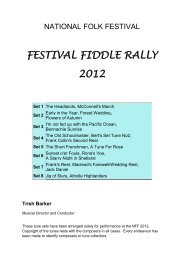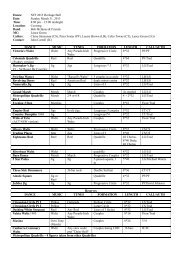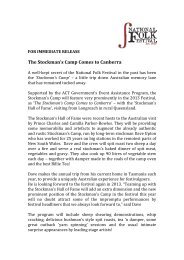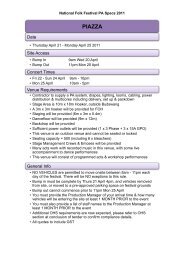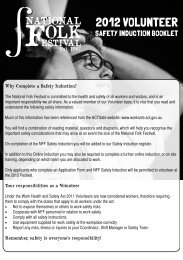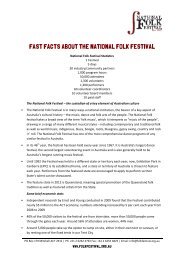Register of Dangerous and Hazardous Substances - National Folk ...
Register of Dangerous and Hazardous Substances - National Folk ...
Register of Dangerous and Hazardous Substances - National Folk ...
Create successful ePaper yourself
Turn your PDF publications into a flip-book with our unique Google optimized e-Paper software.
To comply with requirements <strong>of</strong> the <strong>Dangerous</strong> <strong>Substances</strong> (General) Regulation 2004 Certain dangerous substances, you must include the following classes <strong>of</strong> dangerous substances (listed below) in your register: Class Nature <strong>of</strong> Hazard Class Nature <strong>of</strong> Hazard1 Explosives, pyrotechnics, flares,nitroglycerene6.1 Toxic substances2 Gases (e.g. acetylene gas, LPG) 6.2 Infectious substances3 Flammable liquids (e.g. unleaded petrol) 7 Radioactive substances4 Flammable solids (cooking oils, biodiesel, ethanol, kerosene, methylatedspirits)8 Corrosive substances (e.g. bleach)5 Oxidizing agents 9 MiscellaneousC1Combustible liquid – with a flashpoint <strong>of</strong>150 o C or lessC2Combustible liquid - with aflashpoint <strong>of</strong> more than 150 o CClass: <strong>Dangerous</strong> substances are grouped into classes assigned under the ADG Code according to the nature <strong>of</strong> the hazard (see the table above). Combustibleliquids are not classified as dangerous goods by the Australian <strong>Dangerous</strong> Goods (ADG) Code, but are categorised as either C1 or C2, according to theirflashpoint. An example <strong>of</strong> a combustible liquid is diesel.Subsidiary risk: Where dangerous goods present more than one hazard. An example <strong>of</strong> a subsidiary risk is a pesticide which belongs to Class 6.1 (toxicsubstances) that also contains a flammable solvent (Class 3) base.Packing group (PG): The degree <strong>of</strong> danger presented by dangerous substance is signified as follows:Packing Group I - high danger; Packing Group II - medium danger; Packing Group III - low dangerThe maximum quantity <strong>of</strong> the dangerous substance is the actual quantity what you have or are likely to have on the premises during the event. The expectedaverage quantity will reflect the usual changes in the amount <strong>of</strong> the dangerous substance over the course <strong>of</strong> the event. The figure will be less than the expectedmaximum quantity.The register should also contain a list (<strong>and</strong> quantity) <strong>of</strong> all <strong>Hazardous</strong> <strong>Substances</strong> being used or stored at your site, eg. Johnsons h<strong>and</strong> cleanerFor more information: http://www.ors.act.gov.au/workcover/WebPages/DangSubs/ds.htm 2



